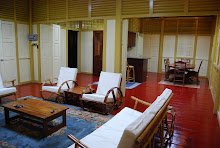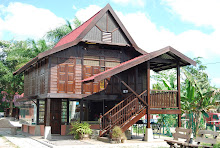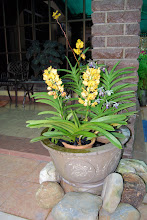It would not be safe to take them to the fast flowing Baling River and with the water quite coffee-colored after a heavy downpour the previous night. So the stream was suggested. It was a marvelous suggestion as we found the place extraordinarily peaceful, tempting and delightful for the children as well as anybody who have been in the maddening cities for sometimes. The cool, light forested corner with gentle flowing mountain stream dashing against pebbles and sand that have barricaded one piece of its bank is indeed a good respite for the juniors and seniors alike. Not likely to impress anybody with descriptions however flowery and imaginative it may be, what excellent way is to take a look at the photos accompanying. I am assured you will be tempted to seek similar corners if possible. I came home with a basketful of polished eroded pebbles fit for the fish aquariums too among other things.
 It is fortunate that such corners of serenity are still available
It is fortunate that such corners of serenity are still available The young brother and his sister having the best time frolicking in the mountain stream. Notice the pebbles strown on the side.
The young brother and his sister having the best time frolicking in the mountain stream. Notice the pebbles strown on the side.
It was not the delightful spot that really struck me so much, but the peripheral activities just close by which invariably I perceived escaped the attention of many including those who came regularly to share the splendor that was there.
Remember Shahnon Ahmad and you will of course linked him to one of his great novels namely ‘Ranjau Sepanjang Jalan’ translated it meant “No Harvest but A Torn” It was to be my close apprehension of Lahuma.
Today perhaps I came face to face with ‘Lahuma’. The elderly person tending to his small plot of land was busy moving around doing the necessaries, aided by his wife and relatives. His plot of hill padi was ready for harvesting and he had to reap them as fast as possible. Already, just as Lahuma had dreaded, the small tiny birds have come in groves, chirping away and their resonance echoed in the quite afternoon sun. Any man would panic. Our man Pak Daud by name was in no rush but tended as calmly as possible.
I quote abstracts from the novel Ranjau Sepanjang Jalan:
“Lahuma dijemput menghadapi ILAHI”
“Hidup mesti diteruskan. Tugas Lahuma perlu dipikul oleh Jeha dan anak-anaknya. Mereka tidak harus mati kelaparan, sawah padi perlu menguning. Hujan lebat, banjir besar dan kedatangan ketam serta burung tiak yang menjahanamkan padi perlu ditentang.
Berbekalkan doa dan usaha, mereka tekad – tiada apa yang dapat menghalang perjalanan hidup ini”
I knew Pak Daud was as cautious as possible. He had ascertained the birds ‘burung tiak’ were eliminated as far as possible. But these little creatures can come in squadrons and make light works of the rice stalks. Pak Daud held a pair of the small creatures in his hand, cursing them for continuing to invade his plot although he has taken the necessary steps. So these were the tiny crop destroyers. Just like the grasshoppers, ‘burung tiak’ are just as vociferous. He offered the little creatures if I cared to keep them. They are small. The one he held was the size of Pak Daud’s thumb but in numbers they are disastrous. Still the crabs have not been taken into account yet.
He and his family went about harvesting the crop in the traditional ways and hopefully pray that all would go well. In their moments of exuberance, they ascertained that they would reap a gainful harvest; thankful that they had worked hard. Unlike Lahuma, Pak Daud was still the core member of his family. I looked at him, a man who must have crossed seventy years plus, maybe nearing eighty but still agile, strong and focused at making the best of his toils. No not many would be that exemplary as shown by many hillside plots in the neighborhood left vacant, unattended and overgrown with ‘lalang’ and bushes.
They had built a frail hut on the plot of land, temporarily giving them shelter day or night if necessary. Perhaps the main tarmac road, supply of electricity and closeness to the neighbors and the ‘cherok’ added to give some comfort and security. Lahuma and Jeha of Banggol Derdap in the district of Sik, no more than an hour drive from this village, had no such luxuries forty years ago when Shahnon wrote his novel.
I am thankful that either ordained or by chance I had the opportunity to come across a live situation much discussed by Shahnon Ahmad in his epic novel, read, discussed even crucified at secondary, college and tertiary levels. That it has been made into a film ‘Rice People’ produced in Cambodia in 1994, directed and co-written by Rithy Panh speaks highly of the intrinsic value of the peasants and their livelihood. (The film premiered in the main competition at the 1994 Cannes Film Festival and was submitted to the 67th Academy Award, the first time a Cambodian film had been submitted as a possible nominee for Best Foreign Language Film) See https//en.wikipedia.org/wiki/Rice_People
I have read ‘Ranjau Sepanjang Jalan’ before; imagined the hardship and landscape as described by Shahnon but sincerely have not seen its true self. Today I did even though at a neighboring kampong site and thankful for understanding all that are worth. Maybe the children’s thrill and frolicking in the mountain stream put off what would have been a much deeper recollection of time past when hardship knocked on most peoples’ doors irrespective where they were.
3 December 2008

 "Lahuma tending to his small plot of 'hill padi' which has taken six months to give him the substance"
"Lahuma tending to his small plot of 'hill padi' which has taken six months to give him the substance"
 Notice the special traditional instrument used to reap the rice stalk. This is the 'ketam padi'
Notice the special traditional instrument used to reap the rice stalk. This is the 'ketam padi' He is a happy man. Thankful that his hard work has given him the wealth of hard toiling and the richness of the earth
He is a happy man. Thankful that his hard work has given him the wealth of hard toiling and the richness of the earth

Tiny tots but the plague of the farmers especially when they come in squadrons











9 comments:
Oooohhhh .. so that's what "padi huma" (I assume) looks like!
And that's what a "charok" looks like, too. To be honest, I had no idea what "charok" means. Now I know. And it looks like a beautiful spot. The river pebbles add to the charm. Kena pi cari tempat ni one of these days.
p.s. How are the grandparents holding up being 'nannies'?
p.s. again ... I updated your Blog List. Does it look okay?
One more thing ... Daddy, saw your group pic in the paper (taken with the Education Minister) tapi lupa nak kerat simpan. Unfortunately, only a slight mention of the Kirkby do and no background stories.
Queen. Thanks. A must visit corner while it is there. Kalau ada wang boleh cari tempat sp ini. I was told it is available. Good place to retire and tend to greens etc. Yes saw the NST pix. Ada buku khas yg diterbitkan. many stories and pic too Let you have a look later. We are ok and so too the young children. Thanks again for the update.Love
Pak Non,
Cukup bertuah boleh jumpa Pak Daud berhuma.Di Banggol Derdap aktibiti berhuma dah tammat.Dalam tahun 1972 2 orang maut ditimpa dahan balak semasa berhuma di srengenge.Semua aktibiti 'stop' ,ikut pahaman orang tua2 itulah sumpahan .Boleh caya dan boleh juga tak caya.
Tapi kalau nak memburu pelanduk dan landak mampuih tak akan berjaya.Balik tangan kosong.Dulu ambo boleh tahan 'ciding' dan sokmo berjaya memerangkap binatang yang 'cerdik' itu.Masa itu belum lagi 'disumpah'.Walahuaklam.
Pak Non tak beli padi huma itu ? Proses guna lesong hindik . Wah cukup sedap nasinya dimakan dengan gulai ikan keli campor timun huma.Di celah2 perdu padi huma dah mesti Pak Daud tanam timun huma.Di 'tajuk' benih timun tersebut dengan benih padi.
Dulu dimusim 'mengetam' (tuai padi) rioh rendah bunyi serunai di buat dari batang padi.Daun mengkuang dibuat corongnya (untuk memberi bunyi yang kuat).Saya hidup disuasana begini di masa dulu2 bersama Lahuma dan Jeha.
Dulu lain,sekarang lain.Yang baiknya dulu tak berhaprak macam la ni.
Sdr Mat Isa,
Terima kasih kerana menambahkan lagi pengetahuan kami mengenai padi huma. Maklumlah orang pekan bukan tahu hal-hal sp itu.Tak teringat pula hendak minta beli padi huma tu. Hanya pak Daud hendak hadiahkan saya dua ekor burung tiak. Bagus juga bawa balik AS semua orang boleh tenguk. Depa semua sp saya ketageh hendak tahu serba serbi khusus hal perkampongan. Nanti kita pi tenguk lagi bersama. InsyaAllah.
Pak Non,
Saya baru habis menonton " The Rice People" melalui youtube.Syok juga,tapi ia ubahsuai ikut selera orang kampuchea.
RSJ versi banggol derdap tak dapat di youtube.Saya pun belum pernah tengok walaupun di lakon depan rumah saya.
Terima kasih kerana beri maklumat the rice people.
Saya ada anak angkat dari kompuchea.Nak suruh dia tengok filem tu.
Regards.
Yang herannya ada usaha orang asing mengmertabatkan usaha dan kerjaya penulis terkenal kita. Kita buat apa?
Post a Comment